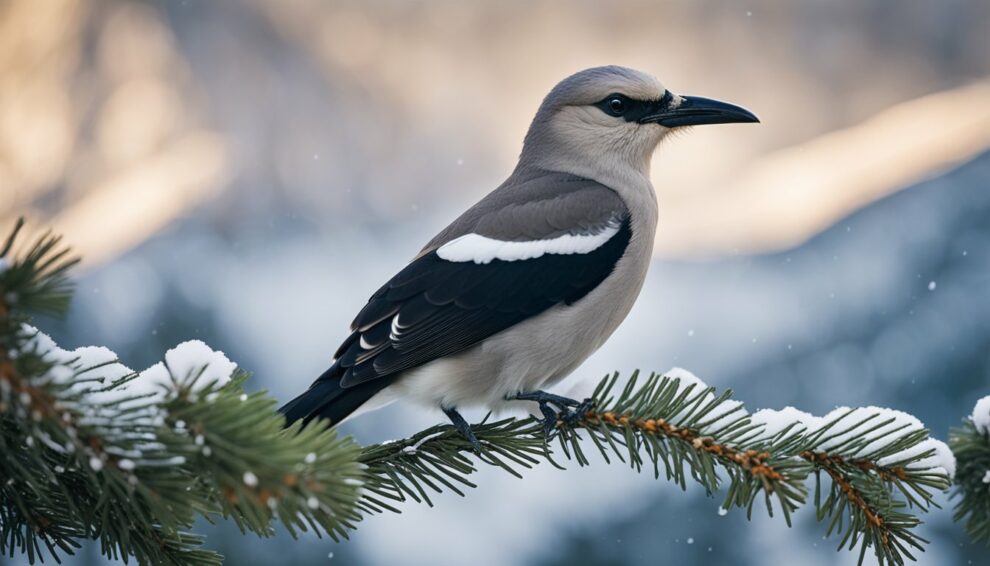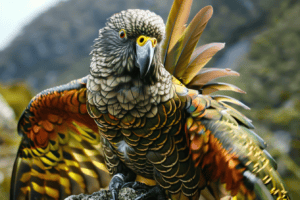Imagine you had to find thousands of treasures hidden in a vast forest, under a thick blanket of snow, with no map to guide you.
That’s a normal day for the Clark’s Nutcracker, a sharp beaked bird with a talent for hiding and finding seeds, specifically from the whitebark pine tree.
In the world of feathered friends, this bird is a brainy standout with a knack for remembering where it cached seeds across the sprawling landscapes.

Why is this important? Well, the whitebark pine trees that the Clark’s Nutcracker loves so dearly rely on this bird for spreading their seeds.
These trees are in a bit of a tough spot with threats to their survival.
The nutcracker plays a key role in the ecosystem, acting as nature’s seed banker, and their memory is crucial for the trees’ regeneration.
Their incredible ability to recall the location of thousands of seed caches, months after burying them, is not just about getting through the winter; it’s a vital part of conservation efforts, giving whitebark pines a fighting chance.
Did you know a Clark’s Nutcracker can hide up to 30,000 seeds in one season?
That’s like memorizing the location of every student in a large school!
Plus, they’re not selfish about it; they often cache more seeds than they need, leaving forgotten snacks to grow into new trees.
So, these birds are not just smart; they’re unknowingly planting the future of whole forests with their remarkable memory.
Isn’t it amazing to think about how this small bird plays such a huge role in keeping our forests alive?
The Clark’s Nutcracker: A Bird of Many Talents
Discover the multifaceted life of the Clark’s Nutcracker, the avian expert of seed dispersal.
It’s equipped with natural tools and behaviors that fortify ecosystems and ensure the survival of various pine species.
Anatomy of a Seed Banker
The Clark’s Nutcracker, known to science as Nucifraga columbiana, is perfectly designed for its role as nature’s seed banker.
Its bill, shaped like a strong dagger, can easily dissect conifer cones to extract the nutritious seeds tucked within.
Much like a built-in storage unit, the bird’s sublingual pouch—a specialized pocket located beneath its tongue—can hold an impressive number of pine seeds.
This adaptation allows the Nutcracker to transport these seeds far away from their parent tree, facilitating the spread of the forest.
Dietary Delicacies
This bird’s diet centers around pine seeds, revealing a fascinating interaction with its habitat.
During seasons when pine cones are abundant, a Clark’s Nutcracker might gather and store up to 500 seeds within an hour, using its specially adapted bill and sublingual pouch.
The seeds act as a rich food source, which the bird deftly harvests and later recovers, even under a blanket of snow.
Its ability to remember the locations of thousands of buried seeds is truly extraordinary—it’s like the bird has a mental map of its very own treasure trove!
Intriguingly, not all seeds are retrieved, which means the Clark’s Nutcracker inadvertently plants new trees, contributing to the health and regrowth of forests.
Masters of Memory: How Nutcrackers Find Their Stash

The Clark’s Nutcracker has a treasure map etched in its brain, which it uses to gather and store seeds across a vast territory.
This map is crucial for their survival through winter months, guiding them back to thousands of hidden food caches.
Remembering the Way
Every autumn, with meticulous care, these bird braniacs stash away up to 80,000 seeds, with typically 2-4 seeds per hidey-hole.
They tuck them under rocks, in the soil, or amongst the nooks of trees. But the real “whoa” moment?
They find every single seed—even under a thick blanket of snow. Imagine that!
You hide your comic books all over the playground and then spot every single one after a blizzard; that’s the kind of superpower we’re talking about.
Surviving the Seasons
Utilizing their spatial memory, which is like an internal GPS, Clark’s Nutcrackers have a special adaptation to remembering where they hide their bounty.
They bury seeds during summer and autumn, ensuring a packed pantry for the cold winter months, because grocery stores are really scarce in their high-altitude mountain homes.
These birds don’t just remember a bunch of locations; they recall the specific spots even months later, with snow piled high as your door.
This talent saves their feathered butts during lean times. Isn’t that something?
What’s your secret to remembering where you put your treasures?
Secrets of the Whitebark Pine: The Nutcracker’s Pantry

Imagine an alpine treasury, where the currency is seeds and the banker is a bird.
This setting isn’t just a fanciful tale; it unfolds in the high-elevation forests where the whitebark pine thrives.
The Intricate Relationship
The whitebark pine and Clark’s Nutcracker share a bond that’s as close as it gets in nature.
These trees rely on the nutcracker’s incredible memory for their seeds to travel and grow.
When autumn arrives, these intelligent birds collect whitebark pine seeds and store them in numerous hiding spots across the forest, almost like little seed vaults.
What’s fascinating is they remember these locations even under a thick blanket of snow. But why stash away so many seeds?
The answer is as simple as it is ingenious: Not all of them will be retrieved, which means those left behind can germinate and give rise to new whitebark pines, continuing the cycle of life in these forests.
Protecting the Pines
Whitebark pine trees are under threat, and their decline could upset the delicate high-elevation ecosystem they support.
Recognized for their critical role, whitebark pines were listed as a threatened species in 2022.
Conservation efforts are focusing on protecting these majestic trees, which includes battling against diseases and pests that target them.
Resilient and important, whitebark pines create habitats for a slew of other species, and their conservation has become a rallying cry for those worried about the future of subalpine ecosystems.
The conservation steps that humans take today—like planting disease-resistant trees—are aimed at securing the pantry for the nutcracker and a whole host of other forest dwellers that rely on the whitebark pine for survival.
Ecosystem Engineers: The Nutcracker’s Role in Nature

The Clark’s Nutcracker is a natural marvel; it is not just a bird but an ‘ecosystem engineer.’ With an astonishing memory, this feathered friend plays a critical role in shaping the pine forests they call home.
Picture a bird, industriously gathering up to 33,000 seeds during the harvest season—scooping them in its sublingual pouch and then darting across the landscape to tuck them away for the winter.
Food Source
For these smart birds, the seeds stashed are not only their pantry but also their tool for ensuring a continuous food supply.
While they use some as food during the snow-clad months, many are forgotten. But don’t you think those seeds go to waste.
Instead, they sprout into new trees, expanding pine forests and refreshing the bird’s dining venues constantly.
Seed Dispersal
Did you know Clark’s Nutcrackers can remember thousands of locations where they’ve hidden their seeds?
What’s more, they can spread these seeds over areas as vast as 20 miles away from the mother tree.
This isn’t just random chance; it’s strategic placement, which allows pine trees to colonize new territories and enrich the biodiversity of the forests.
Conservation Efforts
Sadly, the whitebark pine, a favorite among these birds, is in trouble due to climate change and other threats.
The good news is that researchers are unpacking the secret lives of these birds to help in conservation efforts.
By understanding how Clark’s Nutcrackers contribute to the survival of whitebark pines, scientists can develop strategies to protect these important trees and, by extension, the ecosystems they support.
In their unassuming way, Clark’s Nutcrackers are tireless workers, ensuring the health and growth of their woodland habitats.
They remind us that even the smallest creatures can have a large impact on the world around them.
Isn’t it wonderful how nature works together so beautifully?
Frequently Asked Questions

In uncovering the mysteries of the Clark’s Nutcracker, several intriguing questions arise.
These nutcrackers have a staggering ability to locate hidden seeds, playing a vital role in their ecosystems.
Now, let’s explore their remarkable capacities and the challenges they face.
How can the Clark’s Nutcracker remember the locations of so many seeds?
The Clark’s Nutcracker has an exceptional spatial memory, allowing it to recall the locations of up to 20,000 cached seeds.
Researchers suggest that they use visual landmarks and possibly even the arrangement of the stars to navigate to these cache sites, even when buried under deep snow.
What role does the Clark’s Nutcracker play in forest ecology?
They are nature’s proficient seed bankers.
By burying seeds and then only retrieving a portion of them, they inadvertently plant new trees, shaping the landscape and fostering a healthy forest.
This seed dispersal plays a crucial role in the regeneration of conifers, especially after disturbances like forest fires.
Could you describe the unique characteristics of the Clark’s Nutcracker’s beak?
Designed like nature’s multitool, the Clark’s Nutcracker’s beak is both strong and sharp, perfect for prying open pine cones.
Their beaks can also intricately sort seeds from the chaff and have an expandable pouch below their tongue to carry over 100 seeds at a time for caching.
In what ways do human activities impact the Clark’s Nutcracker and its habitat?
Human activities such as deforestation, climate change, and development disrupt their habitat and food sources.
Changes in temperature patterns can cause mismatches in the timing of seed availability, adding stress to their survival and influencing their crucial role in forest ecosystems.
What kind of symbiotic relationship exists between the Clark’s Nutcracker and whitebark pine trees?
The whitebark pine relies heavily on the Clark’s Nutcracker for seed dispersal.
The tree’s seeds are spread through the nutcracker’s caching behavior, as the seeds they forget to retrieve can germinate and grow into new trees.
It’s a mutual relationship where both species benefit: the birds get a food source, and the tree earns a chance to thrive in new locations.
How do the behaviors of the Clark’s Nutcracker contribute to seed dispersal?
Their behavior of caching seeds over a wide area ensures that not all seeds are found and eaten.
The forgotten caches provide a chance for seeds to germinate, thus aiding in the spread of various tree species.
Their flight patterns and caching strategies mean they can disperse seeds across different elevations and climates, diversifying the forest genetic stock.









